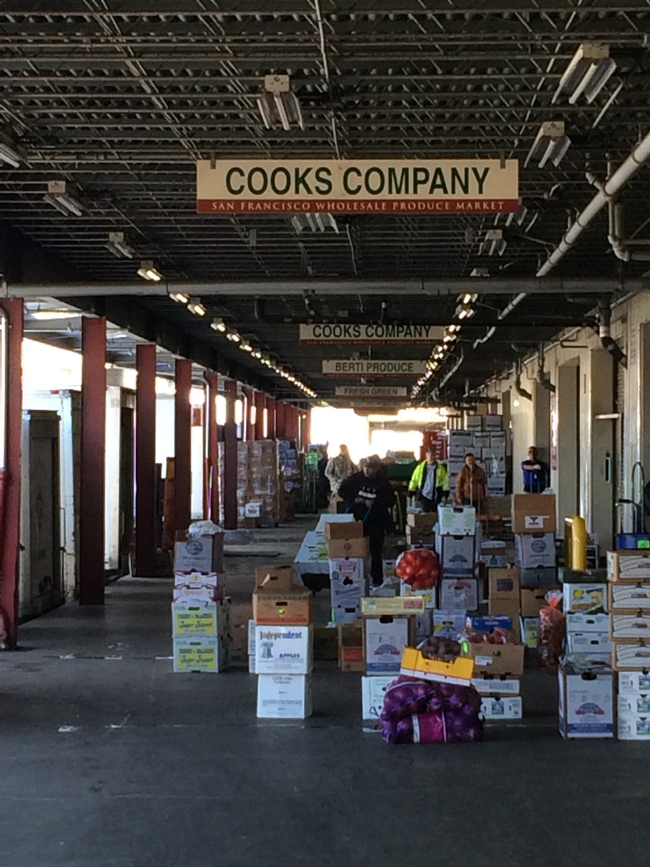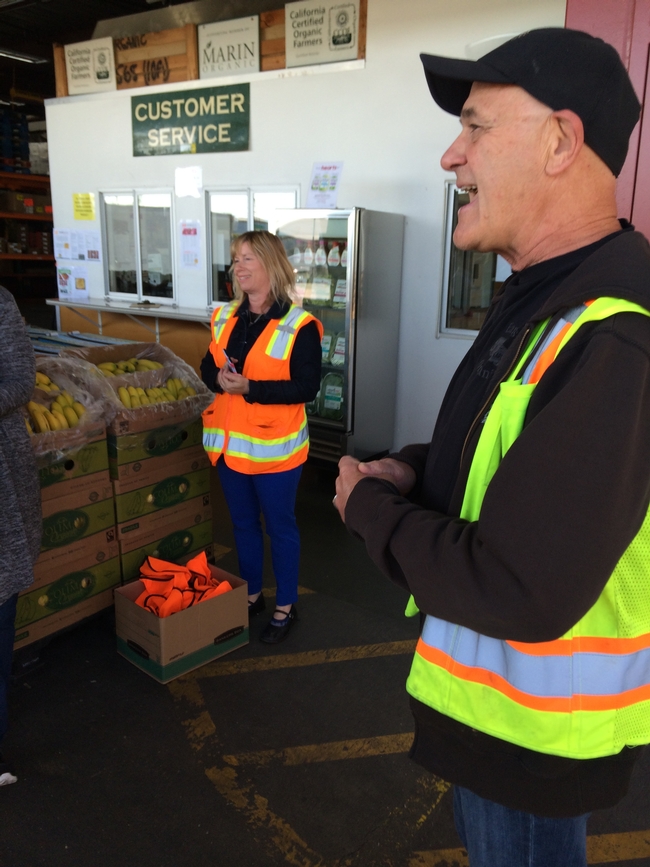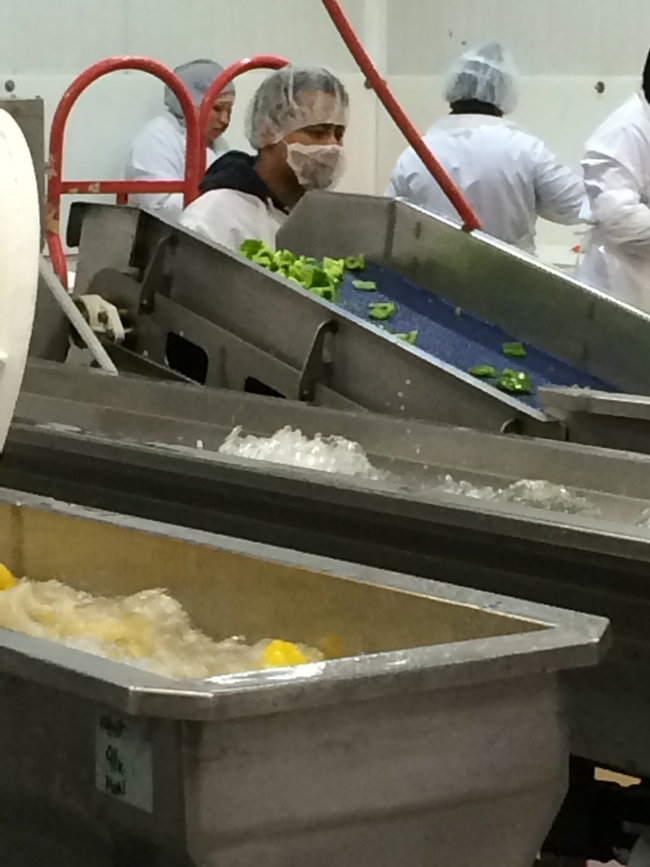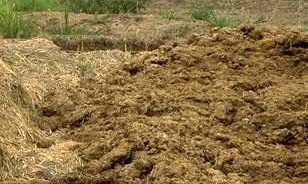
Posts Tagged: produce
Exploring Bay Area Wholesale Market Options
On June 13, the Small Farm Program partnered with UCCE Small Farm Advisor Margaret Lloyd to conduct a tour of wholesale produce markets for Sacramento region farmers. During the bus ride from Woodland to San Francisco, I described the packaging and grading standards that farmers must comply with when selling wholesale.

Cook's Company was established as a wholesaler to Bay Area restaurants in 1985 by chefs Ric Tombari and Elaine Jones Tombari, the generous funders of this tour. Cooks buys from about 300 farms, and delivers to Bay Area restaurants all seven days of the week. Cooks takes same day orders and has no minimum purchase requirements.
Ric greeted our group warmly and then led us through the warehouse while enthusiastically sharing a wide variety of tips that can enhance the viability of small-scale farms selling to restaurants, including:
- wait until your farm has something really good to offer before approaching a potential buyer;
- have a good story about your farm when talking to prospective customers
- seek out new customers in places where there are lots of restaurants;
- sell your berries in open flats because they will look farm fresh, when compared with berries in clamshells;
- remember that chefs want similarly sized tomatoes in a variety of colors; and
- consider unusual forms of produce, such as Fava bean leaves, Savoy spinach (salad dressing clings well to its bumpy surface), baby turnips and Kennebec (chip) potatoes.

The organic food delivery company, Good Eggs, moved into part of a new $24 million 82,000 warehouse at the Wholesale Produce Market in 2015. It packages and delivers produce, meat, dairy products, meal kits, flowers, condiments and wine from local farms and food businesses that customers buy online. Designed to “bring the farmers market to your door”, it was founded in 2011 and expanded quickly into Los Angeles, New York and New Orleans, but closed all of its operations except for the San Francisco facility in August 2015. Its founder, Rob Spiro, stated that Good Eggs did not realize how complicated it is to create a new category that requires a different approach to supply chains, logistics, and commerce – in order to get food from local producers to consumers' kitchens. During our visit, Produce Category Manager Ben Hartman commented that they had to add imported products because consumers wanted some items year-round. Good Eggs begins receiving deliveries at 4:30AM. It delivers seven days a week; orders received by 1PM can be delivered in the evening.

Our final stop was Bay Cities Produce in San Leandro. The family-owned business supplies produce primarily to institutions, foodservice and government organizations in the East and South Bay Area. It carries a full line of fresh, frozen, and custom cut produce (both conventional and organic), including sliced, diced and julienne vegetables. Bay Cities also supplies whole peeled vegetables, salad mixes and cleaned lettuces. Much of the produce is hand cut, which means that customers have transferred their employee safety risk to Bay Cities. After signing in and donning lab coats, hair net and beard nets, we observed many examples of Bay Cities' commitment to cleanliness, sanitation and food-safety during our tour. Vince Del Masso explained that the company spends over $500,000 annually on its food safety program to meet its customers' high food safety requirements. Bay Cities buys most of its produce from California farms. It will provide technical assistance regarding food safety practices to smaller-scale farmers who are interested in becoming its suppliers.
Organic produce growers sought for research study
“The goal of our study is to provide organic farmers with science-based strategies that effectively limit food-safety risks when using raw manure-based soil amendments,” said Alda Pires, UC Cooperative Extension urban agriculture and food safety specialist in the School of Veterinary Medicine at UC Davis.
To study the survival of pathogens in soil and soil health, UC scientists are recruiting California growers who use raw or untreated manure in organically grown crop fields.

Pires is leading the project in California with Michele Jay-Russell, a veterinary research microbiologist and manager at the Western Center for Food Safety at UC Davis.
The researchers will visit participating farms eight times over the 2017-2018 growing season.
“We will collect produce, water, soil and manure samples,” said Jay-Russell. “All of the samples will be tested for bacterial indicators such as nonpathogenic E. coli and pathogens. We will ask the farmers to complete a short survey. The study is voluntary and all locations and names will be kept confidential.”
Eligible California farms must be certified as organic by the National Organic Program or California Certified Organic Farmers and fertilize with raw manure or untreated manure from dairy cattle, horses or poultry. The farms can grow any of the following produce: lettuce, spinach, carrots, radishes, tomatoes or cucumbers.
For more information or to enroll in the project, please contact Pires at (530) 754-9855 or apires@ucdavis.edu, or Jay-Russell at (530) 219-4628 or mjay@ucdavis.edu.
This study is being conducted in other states by the University of Minnesota, University of Maine, USDA Agricultural Research Service's Beltsville Agricultural Center, USDA Economic Research Service's Resource and Rural Economics Division, Cornell University and The Organic Center. The project is funded by a U.S. Department of Agriculture Organic Research and Extension Initiative grant.
Science-based food safety tips

One of the events that attendees could sign up for was lunch with a scientist at The Ohio State University, located a few miles away from the conference venue. I chose Prof. Jeffrey LeJeune, an infectious disease microbiologist and epidemiologist, because a focus of his research is food safety, one of the topics included in the UC Global Food Initiative that UC President Janet Napolitano launched on July 1.
On the day of the luncheon, a Sunday, we were driven to The Ohio State University in buses the university provided. We assembled in the lobby of the Ohio Union (it was homecoming on campus and the Columbus marathon was in progress nearby), and were soon escorted to the tables of the scientists we had picked. The university kindly (and safely!) provided lunch.
At LeJeune's table, we introduced ourselves to one another. LeJeune began his presentation to his 15 guests by rebuffing the five-second rule. According to this rule, food dropped on the ground will not become contaminated with bacteria if it is picked up within five seconds of being dropped. LeJeune said it does not work. “Eating off the floor violates all food-borne illness prevention advice,” he warned.
Perhaps because we in his audience were all science writers, he proceeded to discuss communication challenges facing scientists. He said most of the emphasis in graduate training is on making discoveries, with hardly any attention paid to communicating these discoveries in lay language to benefit the general public. Other challenges he mentioned are the information explosion we are witnessing, resulting in deaf ears turned to many scientists' voices; and language barriers between scientists and journalists that hinder effective communication.

“The pasteurization of milk was a huge benefit to the health of the human population,” he said. “Most cheeses in the U.S. are pasteurized cheese products.”
We asked him many questions. He answered them all. He explained that the U.S. has the safest food supply. Despite this, pathogens can enter the food chain through live animals, he cautioned. Further, refrigeration could be inadequate. He said about 80 percent of food and vegetable contamination occurs post-farm. His tip for what to eat when traveling: “Avoid raw or unpeeled foods. It is best to choose what is fully cooked and hot.”
LeJeune noted there is no evidence to suggest that GM foods are problematic from a food safety perspective.
“There are some concerns for sure,” he said. “But these are largely economic or political. Nutrition-wise, GM foods can be beneficial. From a food safety and nutritional standpoint, I also see no significant differences between organic produce and non-organic or regular produce. There could be, however, some environmental impacts related to the different production systems.”
More questions followed. A discussion on E. coli bacteria gathered momentum, specifically how E. coli gets infected with a virus and how, when this virus decides to leave E. coli, it releases Shiga toxins, which, in turn, damage cells lining the kidney.
We were so engrossed in the discussion that it came as a surprise when one of the organizers of the luncheon strode into the room to inform us that our hour with the scientist was up and that the bus that had transported us to The Ohio State University was about to leave.
As we rose hastily from our chairs we thanked LeJeune for his presentation, which was clear and to the point – qualities all science (and other) writers appreciate. We know he had other topics to discuss with us: Can I cook my Jack-o'-Lantern after Halloween? (The answer is “Not if it sits out for more than two hours.”) And are raw diets for dogs a public health concern for humans? (The answer is “Your dog is more likely to have Salmonella if it is eating raw food.)
Although we didn't get to these topics, he left us with ample useful information about food safety. On the ride back to the conference, the bus was loud with conversation from the various lunch groups – what had been learned, how best it could be communicated, and how each one of us had made a new friend at the university.
Community gardens help stretch food dollars

This month Susan Algert, UC Cooperative Extension nutrition advisor, published research that shows gardeners can save money by growing their own vegetables.
“Low-income people in cities may be able to improve their nutrition by eating fresh vegetables grown in community gardens,” said Algert, who works with UC Cooperative Extension in Santa Clara, San Mateo and San Francisco counties.
To better understand how community gardens affect the affordability and amount of food available, she recruited 10 gardeners in San Jose to weigh the vegetables they harvested from their community gardens during the spring and summer.
The most common crops they grew were tomatoes, squash, green beans, peppers, onions, eggplants and cucumbers.
The citizen scientist gardeners harvested an average of 0.75 pounds of vegetables per square foot, which is more than the 0.60 pounds of vegetables per square foot USDA calculates as the typical harvest from conventional farming.
Algert found that community gardens produced on average 2.55 pounds of food per plant over the four months. For the season, buying the same vegetables at retail prices would have cost $435 more. People saved more money by growing more high-value crops such as tomatoes and peppers that grow vertically and occupy less ground space, she learned.
“We know that community gardens can be an important source of fruits and vegetables for people who don't live near a grocery store or a farmers market,” said Algert. “This study shows that vegetables from community gardens can also be more affordable than buying from a store. That's important to people who live on a low or fixed income.”
The amount of money people save by growing their own vegetables will vary. “Our citizen scientists who worked on this study are all experienced gardeners,” she said, “A novice gardener would likely need training to get the same results.”
Currently Algert is studying the amount of food grown in backyard gardens of low-income families in San Jose.
“It's a wonderful collaboration of nutrition educators, UC Cooperative Extension small farm advisors, UC Master Gardeners, Santa Clara University and Sacred Heart/Catholic Charities,” said Algert.
Her research team is metering water usage to include in their calculations of the cost of growing the food. The UC Master Gardeners have provided soil, raised beds, seeds and drip irrigation to families who are eligible for CalFresh assistance, formerly called food stamps.
In addition to fresh produce, gardeners get some exercise. “Gardening is an excellent form of physical activity,” said Algert.
The study “Vegetable output and cost savings of community gardens in San Jose, California” is published in the July edition of the Journal of Academy of Nutrition and Dietetics at http://www.andjrnl.org.
The community garden study was conducted in collaboration with the City of San Jose's Parks, Recreation and Neighborhood Services Department, which manages 18 community gardens on 35 acres of land.
Small farmers find new marketing opportunities in San Francisco

The story focused on a tour last week organized by UC Cooperative Extension and the UC Agricultural Sustainability Institute intended to help small growers find new avenues to sell their products.
"Everyone wants to do business with them," said David Visher, a project analyst who helped organize the workshop. "We're not advocating that they choose processors over farmers' markets. We're just trying to show them their options and introduce them to the right people so they can make their own choices."
One of the growers on the tour, Emma Torbert, told the reporter she returned to her farm near Davis with a head full of possibilities.
Read more about the tour in the UC Food Blog post Cultivating connections between farmers and food buyers.

